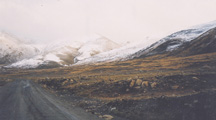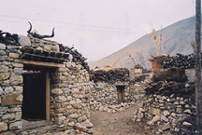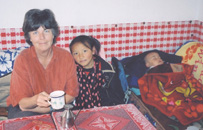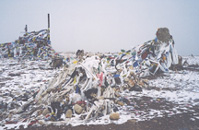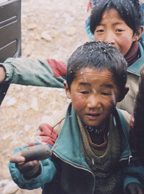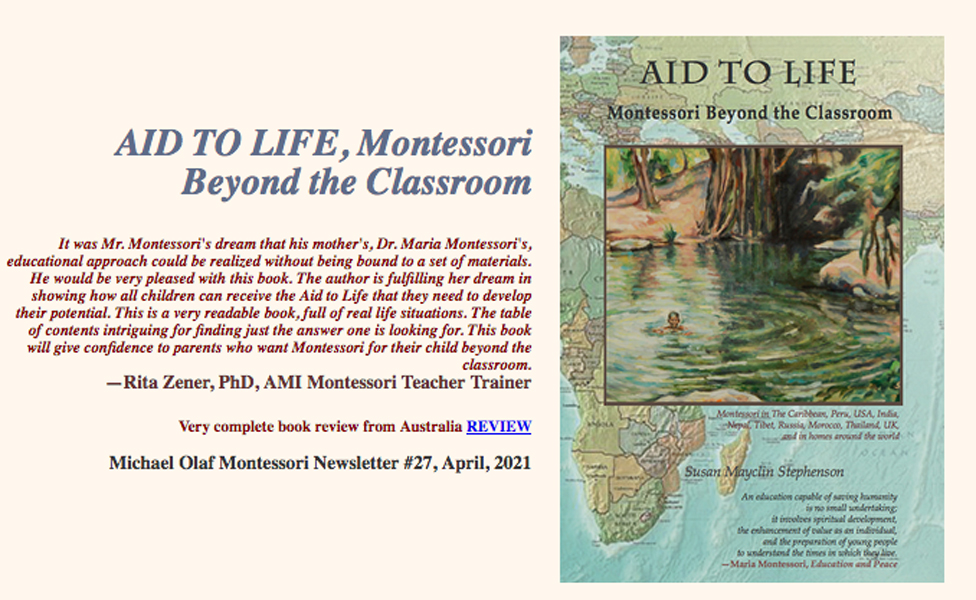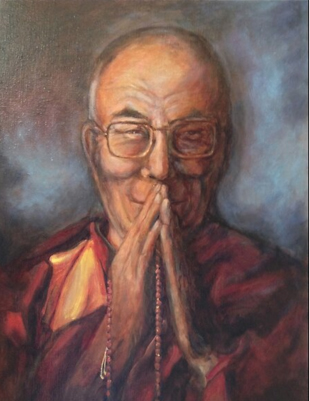|
October 28, 2003 - ROAD TO LHASA
Hello friends,
I am so glad that I didn’t know any more details on this roller
coaster ride (emotionally and physically) from Katmandu to Lhasa ahead
of time; I might not have come, and am so glad that I did. Just experiencing
the windstorms and cold and bad roads, and imagining the refugee children
making the trip, over snow and windy, freezing mountain passes, hiding
and hoping for food and sometimes a ride, and taking 20 days to do it
on foot, was worth the experience!
In Katmandu I met up with Tony and Gail Rossi from home. Gail is a textiles
expert, and Tony leads tours to Tibet and China through Humboldt State
University where he teaches geography. I could not be traveling with better
guides.
Before dawn on October 24th, we were picked up by the driver and guide
who would take us to the border of Nepal and Tibet. Five hours, counting
many police checkpoints, through the lowlands, rice terraces, banana trees,
then up into deep ravines of the Himalayan foothills, over places where
the roads had been practically washed out by the recent monsoons. It was
amazing to look back from several view points, and see the tiny winding
road we had just taken, a little strip of pale hugging the cliffs and
disappearing into the vegetation. And I remember how much easier the trip
looked from the mountain flight.
The first sad moment was at the border - entering the legendary Tibet
we crossed under a huge arch that read “Welcome to the People’s
Republic of China." There were many poorly dressed Tibetans and Nepalese
men, women and children waiting to cross the border from both sides, probably
to day jobs, some virtually in rags, and Chinese soldiers in spanking
new uniforms and good cars.
Our papers were not ready so the first night we staying a dorm room, the
four of us. We took a walk through the border town which was one street
hugging the mountain road, and had food in a little Tibetan cafe where
a young Tibetan girl spent the time trying to explain to us what was going
on on the Tibetan video that was playing, and the pictures of the Potala
on the wall.
I had started taking Diamox, for prevention of Acute Mountain Sickness,
or Altitude Sickness, three days before the trip, but still suffered slight
headache and nausea. Gail, on the other hand, had two serious attacks.
The first was when we stopped for lunch at Tingri. The typical eatery
where we stopped was richly decorated with beautiful Tibetan colors and
images on wall and ceiling. A bench lined all of the walls and small tables
lined the room next to these Tibetan rug-covered seats (no chairs) and
an old stove in the middle room warmed us. The room was filled with pilgrims
and other Tibetans in warm but ragged clothing. We were enjoying reading
the menu, and assumed that “oxygen - large or small” was on
the same level of interesting English misspellings as “chocolate
craps” (crepes) had been in Katmandu, when suddenly Gail almost
passed out and needed the oxygen immediately. Thank goodness it was on
the menu.
Her second bout occurred later in the car. We had bought oxygen to take
along and it was a very good thing because as we crossed the highest pass,
Gyatso-la, 5200 meters (17,000 feet - over three miles high) in the dark
and whirling snow of the night, she had a very serious attack. I held
the oxygen tube in one of her nostrils, while the driver went like mad
to get her to a lower altitude, and the guide, and Barbara, rubbed her
hands and fingers to increase the circulation, and Tony prayed. Finally
she began to come around and could make some movements and sounds. It
was very scary.
For the two highest altitude nights of the 4-day trip I spent the whole
night sitting propped up in bed because I could not breathe lying down.
My resting heart beat was 80-90, instead of 60, and I had several panic
attacks and didn’t know if I was going to make it to my 60th birthday
- it was like suffocating slowly for hours. I had taken the Diamox as
recommended, perhaps more than I should have because by the end of the
trip my skin was covered with a rough red rash, and hundreds of little
open sores - a side effect of the drug. So, do you think you have heard
enough about Tibet, or shall I go on?
BEAUTY - the altitude was not so bothersome sitting up during the day
in the 4-wheel drive car that took the six of us over some of the most
beautiful land on earth. Here we are at the very top of the world. The
guidebook says that the landscape is beautiful but monotonous, but I didn’t
see any monotony. Instead I tried to capture every fold and color and
movement of light and shadow in my memory. The most brilliant blue of
the sky one can imagine, rust, reds, blues, and browns of the mountains
and the only vegetation a dark red-brown low brush and sometimes fields
of low growing dark green feeding herds of sheep and black yaks. As the
sun rose and set the blue was even more beautiful in contrast to the red-orange-yellow
edges of the white clouds. I gave up trying to take pictures because no
single photograph could begin to capture the vastness, shape, and color
of this magnificent landscape.
Several times we passed a single driver on horseback in the fading light
and snow, returning with his sheep and yaks to one of several little black
nomad tent for the night. Once we saw ahead a furious dark gray dust storm
and hoped it would blow away from us but it did not. I closed my eyes,
covered my nose and mouth (no easy decision in a place where oxygen is
rare and precious) and prayed that the driver could see.
In between the high and scary passes, the car being stuck in mud for hours,
and the terrible hotels, with dim light, no heat, and an outside toilet
which was a hole in an outhouse cement floor which one approached with
toilet paper, a candle, and trepidation, we visited several beautiful
old monasteries, and passed pilgrims on there to and from holy sites.
Each high pass is covered with piles of rocks, mani stones, and prayer
flags. There was beauty everywhere.
The houses of the villages in this cold and windy place, high above the
tree line, are all connected, for warmth, yak dung drying on the sides
walls and piles on the top for use as fuel in the winter, prayer flags
fly from short branches (no bamboo of tree branches here), and always
traditional painted decorations in lovely colors above the doors and windows.
The new road, sadly, passed right through the middle of several
lovely Tibetan villages. In the middle of one a woman stood dejectedly
next to a smashed-in wall of her house where the new road would go by.
Finally we entered Lhasa, the capital of Tibet. In the past the Potala,
a giant building of 700 rooms, situated since the 7th century on one of
the two hills of Lhasa, was the first sight anyone would see. Not so today.
One must drive for almost an hour past modern, green-glass, efficiently
ugly, Chinese structures before even catching a glimpse of the Potala,
which has been the seat of the Dalai Lama since the 15th century.
Our hotel, the Yak Hotel, is beautiful, with Tibetan decorations and murals
on the outside and inside of the building, guest rooms with hand painted
scenes from Tibetan history and philosophy, decorated ceiling, good Tibetan
and European food, and Mozart and Afro-Cuban music playing over breakfast
in the lovely dining room. That’s it for now. Welcome to Tibet.
Blessings, Susan
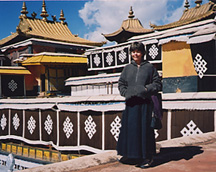
Susan on top of the Potala, Lhasa, Tibet — where
she chose to celebrate her 60th birthday. |
NOVEMBER 7, 2003 - LHASA, TIBET
Lhasa, population 200,000 - elevation 3700 m (12,000 feet)
Hello friends,
I’m at home now in Trinidad, California, awakening from 48 hours
of sleep. It is 4:30 in the morning, and I am going through my trip journal
to fill you in on the last days - as I was unable to safely email from
China anything about Tibet.
As many of you know, Jim and I have been helping the Tibetan Children
in the Montessori classes of the refugee communities in India for a long
time, and I visited there in the fall of 2002. We are often asked why
these children leave Tibet, and if the situation for Tibetans in Tibet
is as bad as one hears, or if it is exaggerated. My trip was largely to
find answers to these questions. I know that I cannot possibly, in such
a short time, begin to understand the total picture, but I can tell you
what I experienced.
The first morning in Lhasa, October 28, Tony led us the few blocks from
the hotel to the 1300 year-old, golden-roofed Jokhang Temple which is
the spiritual center of Lhasa, just as the Potala was once the seat of
government and the winter home of the Dalai Lama (now his home and the
center of the Tibetan Government in Exile is in Dharamsala, India).
The Barkhor is a circular path that encircles the Jokhang Temple. As it
is the end of the growing season and harvests, beautiful rosy-cheeked
pilgrims from all over Tibet have come to pay homage, and to walk the
path or kora, around the temple and other holy places in Lhasa. Such colors
and costumes I could not have imagined possible! Each family/social group
is identifiable by the number of braids and the beads in the women’s
hair, the skirts and aprons, the hats and hairdos, the fabric patterns,
the way the babies are carried, the jewelry, and so on. Large incense
burners over six feet tall dot the path and one has to stay alert and
out of the way of the men, women and children prostrating, or bowing with
the forehead touching the earth, as they make there way around the Barkhor.
Little shop stalls offer for sale monks’ robe fabrics, saddles, prayer
wheels, fruits and vegetables, beads and clothing, strings of dried yak
cheese, musical instruments and Tibetan CD’s and tapes, beautiful
Thangkas (religious paintings), prayer flags, nuts and grains and spices,
and anything else of value to the pilgrims and visitors. Incense fumes
and a chorus of chanted mantras fill the air.
My favorite moments were being swallowed up, surrounded, by a group of
pilgrims who were so happy to have made it to Lhasa and the Jokhand, and
who were chanting “Om mani padme om” in several different pitches,
all coming together and creating overtones, musical vibrations, of peace
and warmth, providing a feeling of being safe in the sounds that reminds
me of the wind in the redwood trees, and the calming ocean waves at sunset
at home. There prayer is one of gratitude, of wishes not for stuff or
success, but for the happiness of all beings on earth. I loved being part
of this kind of worship.
Even though on the surface the Tibetans can practice their religion, they
can only do sincerely at home. Pilgrims worshiping seems fine but that
is probably because they keep moving and do not live in Lhasa.
I cherished the moment that I was walking around the Barkhor and saw two
Chinese policemen peeling an orange to give to a very young Tibetan child
who had wandered over to them. I know that most Chinese people are, just
like the Tibetans, just like us, concerned with their daily happiness,
friends, family, food, shelter, etc. They hear the official propaganda
and do not understand why the Tibetans value their culture, religion,
traditions, and the Dalai Lama, more than new roads and modern buildings.
And I realize that without access to the international news on the internet
that we take for granted, it is impossible for Tibetans and Chinese alike
to get another view of their situation. The Tibetans with whom I was able
to talk candidly were very happy to hear that there are thousands of people
around the world who are working for the sake of the Tibetans inside and
outside of Tibet.
BIRTHDAY - On October 29, I spent my 60th birthday visiting the Potala
Palace, a tour that took three hours. I saw three small European tour
groups, but mostly was again surrounded by hundreds of Tibetan pilgrims
touching their heads to the gates in front of the beautiful statues, and
offering money and the white blessing scarves called katas, and yak butter
which they added to the flaming wicks in small golden cups in front of
the many shrines. There were video cameras aimed at us from the ceiling
at every turn and several groups of Chinese soldiers on every floor. Just
keep moving.
As we neared the floor just below the roof, chanting and drums of a Tibetan
Buddhist ceremony taking place on the roof could be heard. I asked my
guide to inquire about this and was told that it was private and no one
could attend, so I sat very quietly with several groups of pilgrims and
listened to this marvel occurring in occupied Tibet.
Finally we climbed to the roof. The beautiful chanting was still going
on.
Amazingly, the Tibetan woman who takes pictures of visitors on the roof
for a fee asked my guide if I would like to join the ceremony. She opened
a locked gate and led the two of us way across the roof to a small room
where six monks were seated at two long tables in front of an alter, chanting
as they read from books on the tables in front of them, one beating a
very large drum, all pausing now and then to sip the yak butter tea next
to their books. There was a very different feeling in this room. I forgot
that I was in occupied Tibet and felt exactly like the time more than
a year ago when I sat with hundreds of people at the temple next to the
Dalai Lama’s residence in Dharamsala, India. It crossed my mind that
the stories of Tibetan Lama’s being in more than one place at a time,
at lest in spirit just might be true. Sometimes during the talking between
chants, the monks repeated the name “Dalai Lama” and their faces
lit up with happiness. It felt very much like His Holiness was in this
room with us—in Tibet, on the roof of his old home, The Potala. My
guide stayed for a short time then sat outside while I stayed in the room,
tears of happiness on my face, at the good fortune of being present at
this ceremony, and of this magical 60th birthday on the roof of the Potala
in Lhasa, Tibet.
Descending from this, one of the most famous architectural wonders of
the world, we ate lunch at an all-Tibetan local restaurant for pilgrims
and for those who have market stalls near the Potala. I was the only non-Tibetan
there among about 200 people, young and old, turning prayer wheels as
they ate. In the evening I was surprised by a birthday party, complete
with cake and gifts of katas, given by four Tibetans. I think that the
word had spread quickly that I was there to help the Tibetans and could
be trusted. They told me that this was a safe restaurant and they were
free to answer my questions and to tell me their stories.
BRAILLE WITHOUT BORDERS
A few months ago Jim brought my attention to an article in the New York
Times about a project for the blind in Lhasa. I contacted them and made
arrangements to visit. This was one of the most uplifting experiences
of the trip. A young Tibetan girl named Kyla was our tour guide. She had
come to the center from another town three years earlier, when she was
14. At home she had been able to do nothing but help around the house
a little bit, and had no school education at all. Within three years here
she has learned to read and write in braille, and speak, English (her
spoken English was almost perfect), Tibetan, and Chinese. She has written
a play about ecology that has been performed in front of large audiences,
and she is looking for her own apartment and plans to open a tea shop
with a blind friend and to continue teaching at the center.
Three or four years is the limit for being at the center because there
are so many others on the waiting list - so no time is wasted. I was able
to leave some warm clothing, money, and the Tibetan Montessori 3-6 manual
that the Head of the Montessori training at the Tibetan Children’s
Villages in Dharamsala, India had sent me. I think it will be very valuable
to the school.
I left Tibet early, saddened but inspired even more to help the Tibetan
cause. There is much to think about, like forgiveness and understanding.
On the way home, in Chengdu and Hong Kong, I spent some time with lovely
Chinese people. The Dalai Lama, winner of the Nobel Peace Price for his
attempts to dialogue with the Chinese, instead of blaming or hating them,
is my model.
Tashi delek,
Susan |
